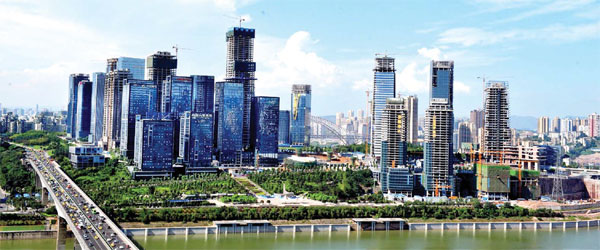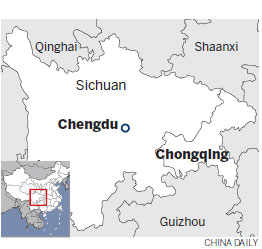City has Western ambitions
Hu Haiyan and Tan Yingzi
Updated:2016-01-29
China Daily Africa
Chongqing tries to cash in on its strategic location with financial services industry
Just as the confluence of two great rivers, the Yangtze and the Jialing, have shaped the character of Chongqing over more than two millennia, two streams of economic policy that have now converged are likely to shape the sprawling city's future for years to come.
The first stream, the country's go-west compaign, has been about 15 years in the making. It set out to extend to western part of the country the economic fruits that had been enjoyed mostly by regions on the eastern coast as a result of the country's opening up to the outside world.

|
Chongqing's Liangjiang New Area, where the city's achievements in the finance industry are evident. Photos Provided to China Daily |

The second, one that adds an international dimension to local economic success, is the Belt and Road Initiative. This grand plan, unveiled by President Xi Jinping in 2013, aims to revive the ancient trade routes that spanned Asia, Africa and Europe.
Serendipitously for Chongqing, western China is a core element of this project. The municipality was carved out of Sichuan province in 1997 to develop China's western regions and coordinate the resettlement of residents from the reservoir areas of the Three Gorges Dam project.
As the Belt and Road Initiative takes shape, many financial institutions have already established a presence in western China to facilitate the finance and trade activities of Chinese companies in Europe and Central Asia, and many more are likely to follow suit.
Dai Zurui, director of HSBC's Chongqing branch, says the bank has watched Chongqing's financial sector grow over the past 10 years as more international companies have set up shop there; and HSBC, like other foreign banks, stands to benefit immensely.
The Chongqing government has forecast that 1.2 trillion yuan ($187 billion; 158 billion euros) will be invested there by 2020, Dai says, and this huge investment calls for participation not only from the Silk Road Fund - set up with an initial capital of $40 billion - but from other financial institutions as well so that a wide range of financial solutions can be offered.
"Infrastructure, goods, services, capital and talent have begun to flow. The Belt and Road Initiative has also accelerated the internationalization of the yuan, which in turn has given a fillip to the financial sector in Chongqing."
Stephen Phillips, chief executive of the China-Britain Business Council and chairman of the EU-China Business Association, says the Belt and Road Initiative is one of the most significant business initiatives of this generation. The opportunities for both UK and Chinese companies are through partnerships, he says.
For British companies, he says, western China's strong suits include financial services and advanced manufacturing, information and communications technology, healthcare and life sciences.
"In our recent report - One Belt, One Road - we included special regional material on the opportunities in Xinjiang, Qinghai, Yunnan, Sichuan and Chongqing. These regions will play a key part in the Belt and Road Initiative and in China's future development."
Chongqing is the biggest of the country's four municipalities (the others are Beijing, Shanghai and Tianjin). The city covers 82,400 square kilometers, the size of Austria, and has a population of around 30 million - equivalent to the combined population of the Netherlands, Sweden and Norway. It served as the country's wartime capital between 1937 and 1945.
During an inspection tour to the municipality in January, President Xi - making his first visit since he took office as China's top leader in 2012 - said: "Chongqing has great potential and a bright future."
Many experts say the visit was a confidence boost for Chongqing and was recognition for its economic and social achievements in recent years.
After leading the country's growth rate for two consecutive years, Chongqing expects to maintain its double-digit record. It has a target of 10 percent for 2016 after growth of 10.9 percent in 2014 and 11 percent in 2015. The national rate was 6.9 percent last year.
Xi said the Belt and Road Initiative will provide a bigger platform for Chongqing to "go out" and that the development of the Yangtze River Economic Zone can help the city better connect with the central and coastal areas of China. He said he hopes Chongqing plays a major role in the go-west campaign, the Belt and Road Initiative and the Yangtze River Economic Zone.

In early November, the central government underlined how important it sees Chongqing to the country's economic future when President Xi, on a visit to Singapore, announced that the city would be given the economic and industrial status that had been bestowed on two other cities: Suzhou, Jiangsu province, with its industrial park set up in 1994; and Tianjin, with its eco-city, which opened in 2008.
The China-Singapore (Chongqing) Demonstration Initiative on Strategic Connectivity will focus on modern interconnectivity and the modern service economy, such as financial services, aviation, logistics and information technology.
Ruan Lu, director-general of the Chongqing municipal finance office, says as the Belt and Road Initiative is implemented it will present opportunities not only to the financial industry, but also to other sectors to set up operations in the city or for those already there to extend them well beyond the municipality.
"The strategy offers a huge opportunity for Chongqing to unlock its potential and embrace the outside world. We are developing innovative financial institutions, services and products now. They include providing offshore financial services, cross-border renminbi settlement and capital support for Chongqing companies looking to expand out of the region, facilitating Chongqing companies getting foreign exchange to expand overseas."
By the end of December, Chongqing's financial assets were said to be worth 4.29 trillion yuan, 14.7 percent more than the previous year, and the finance sector accounted for 9 percent of the city's GDP.
Last year, there were 1,499 financial institutions in Chongqing, a 54 percent increase in just two years.
Chongqing's achievements in the finance industry are evident in its Liangjiang New Area, a national-level development zone that covers more than 1,200 sq km and has a population of 2.2 million.
In the area, set up in 2010, a great deal of effort has been made into building the financial sector. In the first half of last year, the value of the sector grew 11.3 billion yuan or 23 percent.
Many of Chongqing's financial institutions are in Jiangbeizui, a central business district of Liangjiang New Area, and there were about 600 of them by the end of last year. Five years ago, Jiangbeizui was mainly farmland, but it now resembles Pudong, the financial district of Shanghai.
It is projected that within a year or so 80 percent of the municipality's financial institutions will be located there, and that Jiangbeizui will account for 30 percent of deposits and loans in Chongqing.
However, as the finance industry grows, one of the pressing issues it faces is a lack of skilled people.
"We are looking for more skilled people with ambitions to do something different here in Chongqing, a place where there are huge opportunities for growth," says Xu Honghu, director-general of the finance development bureau of Liangjiang.
One of those who is looking to make the most of those opportunities is Yang Yusi, director of the investment and development department of Chongqing Liangjiang Financial Development Co Ltd.
Yang says he returned to Chongqing in 2011 after working as an investment banker in Hong Kong and now with eight others manages an investment fund worth 20 billion yuan.
"In our team, the average age is under 30," says Yang, 32, one of the youngest senior managers in his company.
"Of course, Chongqing's financial sector is not as developed as those of Beijing or Shanghai, but here there are more opportunities for skilled people like us to build something from the ground up."
Dressed in a formal suit and speaking in a skyscraper located in the Jiangbeizui district, Yang says he is happy with his decision to give up a well-paid investment banking job with Citibank.
"I am very excited to come back to work in Chongqing. There is so much potential to tap in the financial industry. Especially after the implementation from the Belt and Road Initiative, the financial industry will gain more impetus to take off."
The municipality is also well endowed with strong transport links, not only with the rest of China, but Europe as well, the jewel in the crown of this being the Chongqing-Xinjiang-Europe Rail that crosses 11,000 km and six time zones.
At a railway station in Chongqing, dozens of workers are busy loading cars and electronic goods onto a freight train. After a 15-day journey that takes in Kazakhstan, Russia, Belarus and Poland, the train arrives in Duisburg, Germany.
One company that uses the line is Chongqing Lifan Co Ltd, one of the largest domestic car and motorcycle makers in China. Yin Mingshan, the company president, says the Belt and Road Initiative offers huge development opportunities for Chinese companies.
"When Lifan was set up, we decided to focus mostly on the domestic market," Yin told a conference in Chongqing. "But we realized that we faced formidable competition. We decided to focus on overseas markets, as that offers higher profit margins even though there are greater obstacles to overcome."
Contact the writer through huhaiyan@chinadaily.com.cn
Video

John Edwards, the UK trade commissioner for China, praised Chongqing over its rise as a burgeoning center in intelligent manufacturing.






